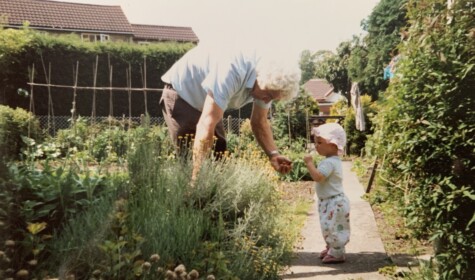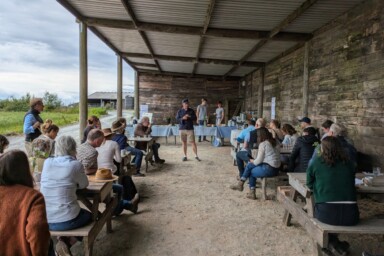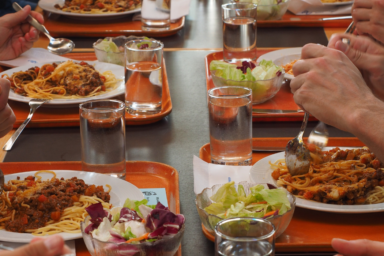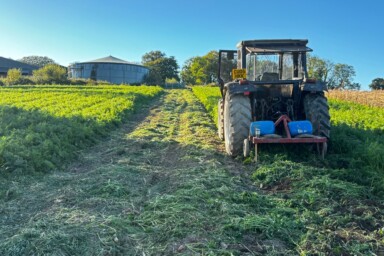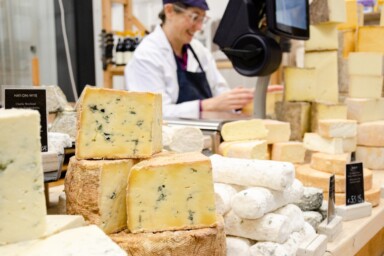When I was a child, my father and grandfather had a garden. My mother and grandmother had a kitchen. The women used the garden to hang out the washing and to move kitchen activities, such as shelling peas, into the fresh air on a sunny day. The men used the kitchen to prepare shallots for pickling and to warm up in front of the fire on a cold day. On Saturdays, the men were allowed to use the cooker to grill tin plates full of bacon, cheese and ‘gibbles’ (small onions) for dinner.
The small front garden had flowers in it, and it was there that Mum and Nan put out the kitchen chairs to do whatever work was at hand, and to drink tea and chat with the neighbours or whoever should pass by.
Neither the garden nor kitchen were ever considered to be places of recreation. Everything had a functional use and there was no room for patios, ponds or garden ornaments. Many of the objects that now would be considered creative ‘up-cycling’, or ‘shabby chic’ were just re-purposed out of necessity – very little got thrown away.
This scenario was typical of the farming and coal mining community that my village was then, and no doubt typical of similar villages around the country.
As a child, you didn’t really consider what you were in terms of class or wealth, but I was never in doubt that it was from the garden that we primarily got our food, and it was in the kitchen that basic ingredients were turned into meals. I didn’t consider my parents, grandparents or fellow villagers to be skilled in ‘self-sufficiency’, but they were, long before ‘self-sufficiency’ was invented.
Fast forward to the present day and it is sobering to witness the knowledge that has been lost in the intervening years. Sometimes I wonder at what point our self-reliant food system got broken. While tomato and turnip jokes abound on social media, our complacency in expectations of plastic wrapped, out-of-season salad from Spain is alarming to say the least.
Our family never grew tomatoes. We didn’t need to because we got them from Mr Bendix along the lane. Viktor Bendix was a German prisoner of war who married a local girl and stayed. His large cottage garden had several glasshouses from which most of the village got their tomatoes and cucumbers throughout the summer.
We didn’t grow turnips either. They took up too much room and were easy to get by the sackful from local farms, as were swedes.
We swapped leeks for cabbage with Mrs Sampson and for cauliflowers with Mr Gill. The system was both simple and complex – a community orchestra without the need for a conductor because everyone knew their own part so well. We operated on both individual and community levels. Every family had their own preferences and techniques, but that individuality was closely woven with neighbourly collaboration.

When I think about it now, it feels like it was a longer time ago than it actually was. I have no doubt that what my family were doing to feed themselves in the 1960s, had changed little since the 1860s. Not only were we growing and eating fresh produce straight from the garden, we were also storing for most of our winter needs as well.
My father knew which vegetables could be overwintered outside and which needed to be brought into the sheds or house. We buried carrots in boxes of damp sand, to eat after the last of the late crop were gone and before the little first earlies put in an appearance.
My grandmother collected big glass sweet jars from the village shop, that might have a crack or a broken lid, (recycling before ‘recycling’ was invented), and filled them with runner beans layered with salt. These would last for months; the salt being sieved out and stored in a stone jar to be reused as each layer of beans was cooked in turn.
We foraged, before foraged food became the preserve of trendy restaurants. Pretty much any walk involved carrying a basket and often my grandfather would bring the little cart he made from scraps of wood and old pram wheels to take home ‘stick’ for the fire.
In peak seasons, we would take picnics and stay out all day, coming back at sunset with scratched arms and legs and purple fingers and mouths. Picking blackberries, whortleberries and the like was fun, but we were never under the impression it was an optional activity – you didn’t go home until you had picked enough.
Day trips to the seaside usually brought home enough mackerel to feed half the village, plus buckets of cockles and winkles, that were winkled out with a pin.
The current food shortage ‘crisis’ would have completely mystified my grandparents. Why would you want to eat tomatoes in February? Why would you want to eat tomatoes imported from Spain at all? Bretons on bicycles with strings of onions round their necks was as exotic as it got.
In a few short decades, much of Britain has surrendered self-reliance and regional autonomy to large corporations, primarily supermarkets peddling cheap, nutrient-depleted, chemically assisted products. We were all drawn in, first by novelty (sawdust-like Parmesan cheese in plastic pots, olive oil to put in your ear!), then, as tradition and knowledge began to unravel, by lack of choice.
As a child, I grew up on the tail end of age-old food production methods and systems. I realise now that we ate what suited our land and climate. We were organic before ‘organic’ was invented – fertiliser came in the form of compost, ash, soot, cow manure and special herbal cocktails, if it was deemed there was a need. Pest control came in the form of bits of rhubarb leaf jammed down the side of cabbage plants and my Dad doing a war dance because the sparrows had picked the flowers off the beans again.
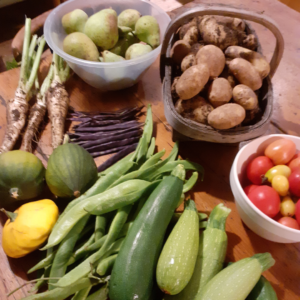
It may appear that I am presenting a rose-tinted picture of an idealised childhood, but it is only idealised by those who make it a life-style choice. There is little romance in maintaining a fully functioning vegetable garden after a shift down a coal mine as my grandfather and uncles did. And many would-be ‘good lifers’ would baulk at the sight of a dead chicken hanging by its feet from the washing line with the blood running down the garden path.
However, while coal mining needs to be consigned to history, our relationship with locally-grown and home-cooked food needs to be urgently revived. For too long, our ideas of food have been skewed by the deception that it should be cheap, factory produced and untouched by the variabilities of season, region and country. We have become so used to not questioning the availability and the real cost of those out-of-season Spanish tomatoes – water, chemicals, loss of habitat and wildlife, an increasing carbon footprint and ubiquitous plastic packaging – that we now think their absence is a crisis.
And while newspapers and social media rage over the perceived unfairness of Spain sending its weather depleted stocks to other EU countries, queues outside the UK’s embattled food banks continue to grow ever longer. Facing a seemingly precarious future, one that is defined by scarcity and collective disempowerment, the question begs to be asked: can we still summon the knowledge, skills and will to reclaim our food system as our own? As corporations turn something as essential as food into a ‘commodity’, is it any surprise that we have forgotten the value of self-reliance.
This piece was published in conjunction with Wicked Leeks.
Photos courtesy of Julie Baber.
